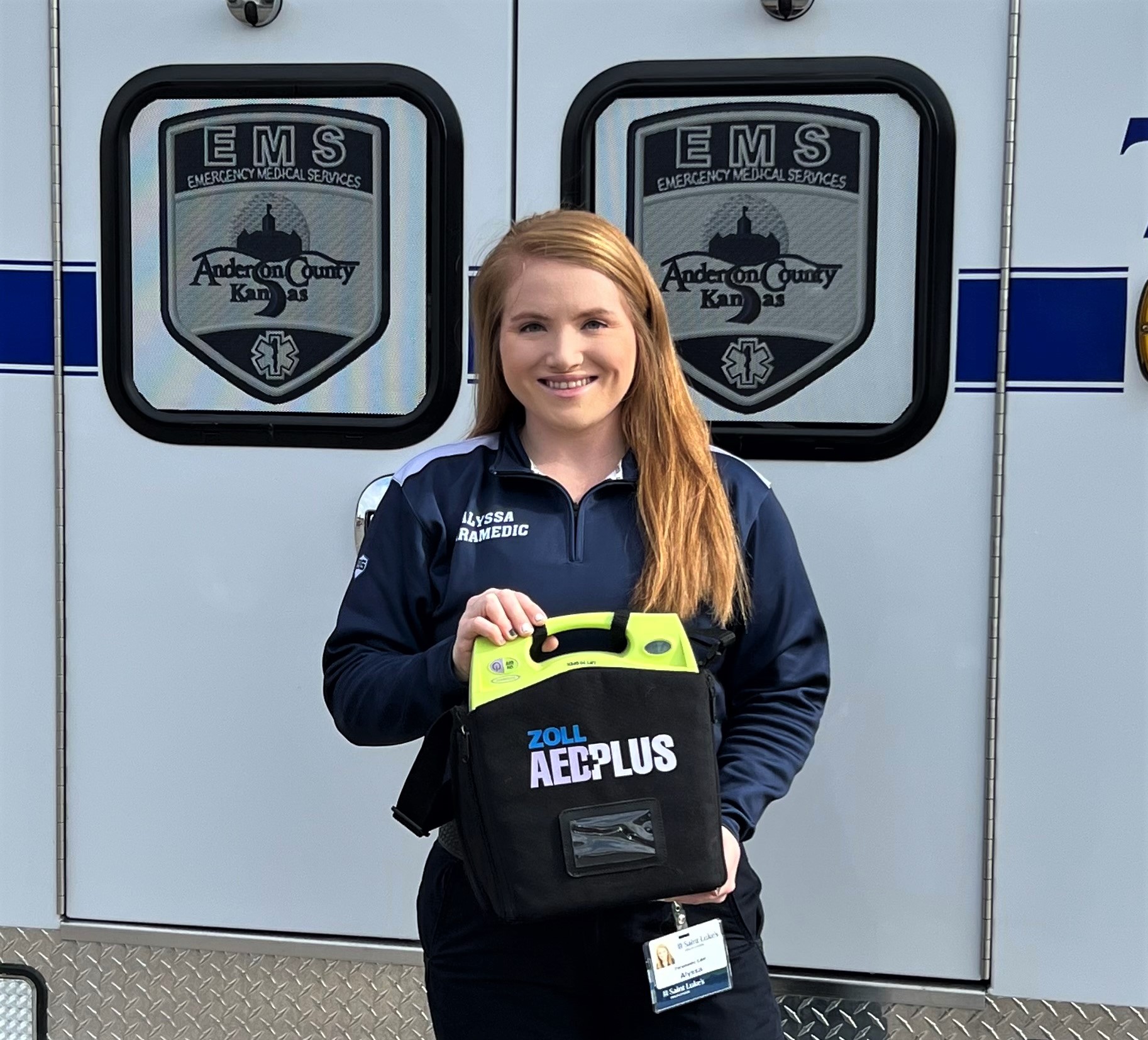Anderson County EMS Launches Effort to Locate and Register All Area AEDs

Paramedic Alyssa Esson
Garnett, Kansas – As part of an effort initiated state-wide by the Kansas Board of Emergency Medical Services, Anderson County EMS is asking community members to help register all area automated external defibrillator (AED) devices through PulsePoint AED.
PulsePoint AED allows users to register AEDs which can be located on a map for quick access during a cardiac emergency. AEDs can be registered by anyone anywhere by downloading the free PulsePoint AED app. Simply add the location and a photo of the AED in the context of its surroundings.
Devices registered through PulsePoint AED located within Anderson County will be investigated and vetted by Anderson County EMS. Paramedic Alyssa Esson has prior experience with PulsePoint AED and is eager to lead the effort for Anderson County.
"Asking community members to help register AEDs in Anderson County is the first step in the process," shared Esson. "Once we see that a device has been registered on PulsePoint AED, we'll reach out to identify who the owner is, verify the AED's location, confirm if or when the device can be accessed by the public, and review the maintenance history to make sure the AED is in good working order."
Anderson County EMS will share AED registration information with local emergency dispatchers to record in their system, so instead of asking the caller if there is an AED available, dispatch center staff can inform callers of nearby lifesaving devices.
Anderson County EMS covers nearly 600 square miles in Anderson County. Even with volunteer departments located in rural Colony, Greeley, Harris, Bush City, Welda, Westphalia, Kincaid, and Lone Elm, it can take some time for help to arrive.
"The PulsePoint AED app displays where all the registered AEDs are located on a map," Esson demonstrated with one touch on her mobile smartphone. "We encourage anyone who is CPR-trained to download the PulsePoint AED app for information on AEDs in your geographic area. As more AEDs are registered in Anderson County, and across the state, the more useful this tool will be."
Early application of bystander CPR and rapid defibrillation from an AED have proven to be crucial in improving a person’s chance of surviving sudden cardiac arrest.
“With PulsePoint AED, we hope to create greater awareness throughout our community around the important role CPR-trained bystanders and AEDs play in out-of-hospital cardiac arrest survival,” said Troy Armstrong, Manager of Anderson County EMS. "We'll also be offering CPR courses to get even more folks trained and prepared to respond in an emergency."
"Having an accurate AED registry within our community, along with increasing the number of CPR-trained bystanders, can greatly improve the odds during a cardiac arrest event and can help save a life."
For questions about registering an AED or to learn more about CPR training opportunities through Anderson County EMS, please contact Sherry Schmitz, Education Coordinator, at 785- 204-7194.
About Anderson County Hospital
Anderson County Hospital is a member of Saint Luke’s Health System, which consists of 14 area hospitals and several primary and specialty care practices, and provides a range of inpatient, outpatient, and home care services. Founded as a faith-based, not-for-profit organization, our mission includes a commitment to the highest levels of excellence in health care and the advancement of medical research and education. The health system is an aligned organization in which the physicians and hospitals assume responsibility for enhancing the physical, mental, and spiritual health of people in the metropolitan Kansas City area and the surrounding region.
About the PulsePoint Foundation
PulsePoint is a 501(c)(3) non-profit foundation based in the San Francisco Bay Area. Through the use of location-aware mobile devices, PulsePoint is building applications that work with local public safety agencies to improve communications with citizens, increase civic engagement and empower the community to help reduce the millions of annual deaths from sudden cardiac arrest. Learn more at pulsepoint.org.
About Sudden Cardiac Arrest
Although a heart attack can lead to sudden cardiac arrest (SCA), the two are not the same. SCA is when the heart malfunctions and suddenly stops beating unexpectedly, whereas a heart attack is when blood flow to the heart is blocked, but the heart continues to beat. Each year, more than 326,000 out-of-hospital cardiac arrests occur, making it the leading cause of death in the United States. Survival rates nationally for SCA are less than eight percent, but delivery of CPR can sustain life until paramedics arrive by maintaining vital blood flow to the heart and brain. However, only about a third of SCA victims receive bystander CPR. Without CPR, brain damage or death can occur in minutes. The average EMS response time is nine minutes, even in urban settings; after 10 minutes there is little chance of successful resuscitation. The American Heart Association estimates that effective bystander CPR, provided immediately after SCA, can double or triple a person’s chance of survival.